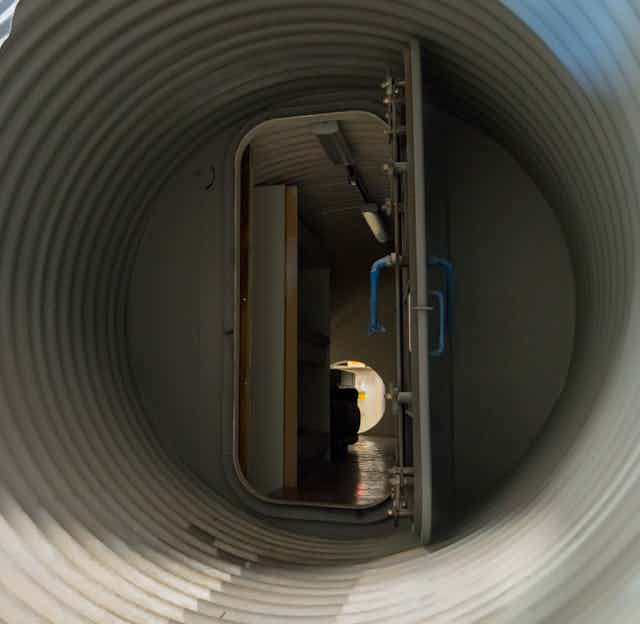Nestled among Kansas cornfields in a landscape devoid of any noticeable natural topography, a verdant mound can be seen from a dirt road. Surrounded by a military-grade chain fence and in the shadow of a large wind turbine, a security guard in camouflage paces the fence line with an assault rifle. If you look closely, you might notice what looks like a concrete pill box perched on the top of the small hill, flanked by cameras. What lies underneath is a bunker that is unassuming, unassailable and – to many – unbelievable.
To the outsider it looks a bit like a secret government installation – and indeed at one time it was. But this is not a bunker built to hide citizens or to protect the politicians who ordered its construction. It is an Atlas F missile silo, built by the US in the early 1960s at a cost of about US$15 million. It was one of 72 blast “hardened” silo structures built to protect nuclear-tipped Intercontinental Ballistic Missiles with an ordnance 100 times more powerful than the bomb dropped on Nagasaki. Although it was out of sight and out of mind to the average US citizen, it played a crucial role in a geopolitical agenda of extinction-level significance during the Cold War.
However, that was then. The bunker is now no longer owned by the government, but by Larry Hall, a former government contractor, property developer and self-confessed doomsday “prepper” who purchased it in 2008. Preppers are the people who anticipate and attempt to adapt for what they see as probable or inevitable and impending conditions of calamity (ranging from low-level crises to extinction-level events). According to Michael Mills, a criminologist at the University of Kent, preppers build for situations where “food and basic utilities may be unavailable, government assistance may be non-existent and survivors may have to individually sustain their own survival”.
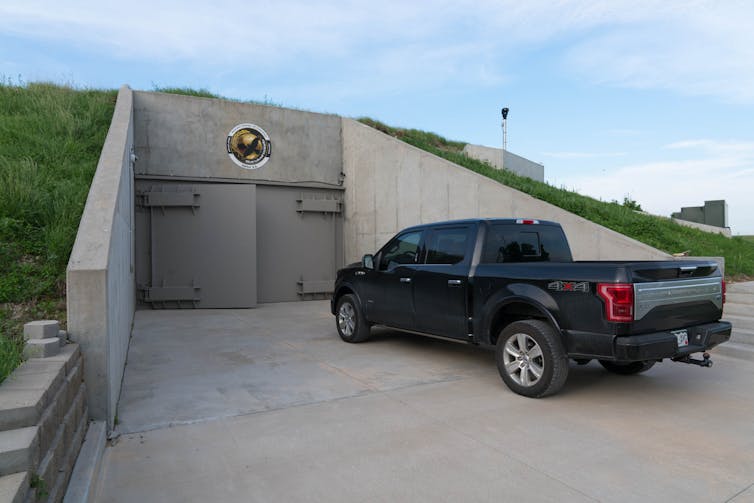
Since purchasing the silo over a decade ago, Hall has transformed this subterranean megastructure into a 15-story inverted tower block – a “geoscraper” – now dubbed Survival Condo. It is designed for a community of up to 75 people to weather a maximum of five years inside a sealed, self-sufficient luxury habitat. When the event passes, residents expect to be able emerge into the post-apocalyptic world (PAW, in prepper parlance) to rebuild society afresh.

This article is part of Conversation Insights
The Insights team generates long-form journalism derived from interdisciplinary research. The team is working with academics from different backgrounds who have been engaged in projects aimed at tackling societal and scientific challenges.
I spent three years conducting ethnographic research with nearly 100 preppers from six countries, including Australia, the UK, Germany, Thailand, Korea and the US. I’ve hung out in bunker complexes on the Great Plains, with groups growing food in secret forests, with people building heavily armored vehicles, and with religious communities that have collected supplies that they’re ready to hand over to strangers in need. According to these preppers, the ongoing COVID-19 pandemic is merely a “mid-level” event – a warm up for what is to come. They anticipated and prepared for a disaster just like this one, and – unlike most of us – say they weren’t caught by surprise.
Most preppers are not in fact preparing for doomsday – they’re everyday people who anticipate and try to adapt for many conditions of calamity; conditions which they believe inevitable and have been exponentially escalated through human hubris and excessive reliance on technology and global trade networks. While the disasters they anticipate might – at the more extreme end of the spectrum – include major “resets” like an all-out nuclear war or a massive electromagnetic pulse from the sun that would fry our fragile electronics, most preppers stockpile for low to mid-level crises like the one the world is experiencing now.
Indeed, a new banner on Survival Condo’s website boasts that the silo’s nuclear, biological and chemical air filters can “screen out” the COVID-19 virus. While most of us wouldn’t build against crisis to this degree, or even get the opportunity to, there are still some lessons I discovered that society can learn from preppers and the way they look at the world.
A brief history of survivalism
Prior to prepping there was survivalism, a Cold War-era practice focused on practical approaches to potential cultural and environmental disasters. One of the primary concerns of survivalists was the possibility of nuclear war. This was a threat which they felt was brought about by scientists, elites and politicians willing to sacrifice citizens in the name of geopolitics. Many survivalists, as a result, were distrustful of heavy-handed government and globalisation – they often dodged taxes and the law while relying heavily on the perceived autonomy enshrined by the US constitution.
Kurt Saxon, the man who coined the term survivalism, advocated for armed revolution and wrote primers on how to create improvised weapons and munitions. Some survivalists, following his lead, became radicalised as they worked to cultivate self-sufficiency by breaking away from government oversight. Both Timothy McVeigh, the Oklahoma City Bomber, and David Koresh, the Waco Branch Davidian leader, were deeply invested in the practice.
In the 1980s and 1990s, the US government persecuted and prosecuted many survivalists in an effort to stamp out the movement, which by that time included up to 3 million Americans. Some of the names involved, such and Randy Weaver (at Ruby Ridge) Bo Gritz (the inspiration for Rambo), and William Stanton (of the Montana Freemen) became household names. Their suppression gave rise to wider frustrations and further anti-government sentiment. Determining that people were becoming “paranoid”, the government then ratcheted up surveillance, which just led to more militancy.
Most preppers today, in contrast, take a distinctly defensive stance in an effort to distance themselves from the politics of early survivalists, focusing more on practicalities than partisan ideological debates. Yet media-driven perceptions often paint crude portraits of them. Walking through the multi-million dollar Survival Condo, built with full planning permission from the State of Kansas, it is obvious that a lot has changed in a few short decades.
Survival Condo
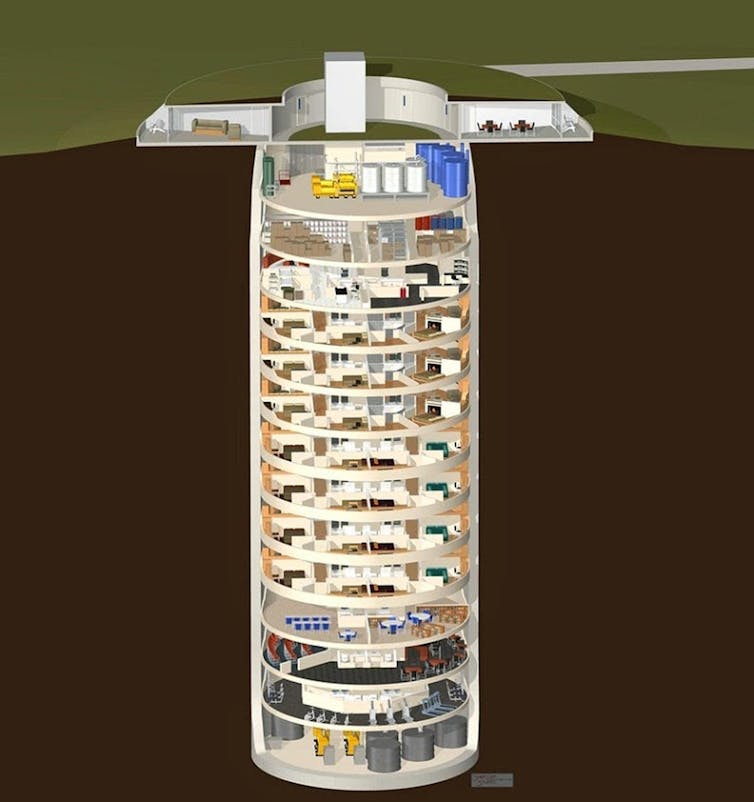
When Hall took me on a tour of the condo in 2018, he explained that “the whole idea was that we could build a green doomsday structure that someone can use as a second home that also happens to be a nuclear hardened bunker”. Hall called it a safe, self-contained, and sustainable “experiment in architecture” – the subterranean equivalent of the University of Arizona’s Biosphere 2 project.
Biosphere 2, also known as the “Greenhouse Ark”, was one of the most ambitious projects in communal isolation ever orchestrated. The three-acre complex had seven “biomes” under glass. In 1991, a crew of four men and four women locked themselves into see if they could survive in a closed system for two years. It concluded with “infighting among the scientists, malnutrition, and other social and environmental pitfalls”, according to one of the original crew members. Hall, however, remained convinced he could improve on the model:
This is a completely closed system. People try to build systems like this on their farms and they get infiltrated by bugs…rain, and wind damage. We’ve removed all those factors.
Hall said that his bunker was good practise for closed systems, such as space travel. Bunkers like Survival Condo, found as far afield as remote villages in Thailand, are distinctly private endeavours that seek to use renewable technologies to decrease dependence on state infrastructure. Survival Condo is also part of a growing desire to “prep” in the most sustainable way possible without necessarily forgoing the comforts of late capitalism. This is a worldview steeped in dread about the speculative unknown.
But it’s not cheap to buy your way out of the existential conundrum. A “penthouse” in the condo would set you back US$4.5 million while a half-floor unit comes in at around US$1.5 million. Since “doomstead” mortgages are not yet a thing, only cash buyers need apply. Incredibly, not only has Hall sold every space in the first silo, he’s now building out a second one, 20 minutes away. This fact reflects an obvious, and growing, unease about the future.
At another location in South Dakota called the xPoint, which I have visited a number of times over the last few years, residents have stumped up US$25-$35,000 for empty concrete bunkers in the middle of the Great Plains. Originally built during world war one to store munitions, these 575 bunkers are now fast becoming the largest prepper community on Earth.
Back in Kansas, I followed Hall through one of the 16,000lb blast doors that can be “locked down” at a moment’s notice. He waved me over to the nuclear, biological, and chemical air filtration unit for the condo and explained that they had three military-grade filters each providing 2,000-cubic feet per minute of filtration, that “were US$30,000 a pop”, says Hall. “I put US$20 million into this place and when you start buying military-grade equipment from the government you wouldn’t believe how quickly you get to that number,” he said.
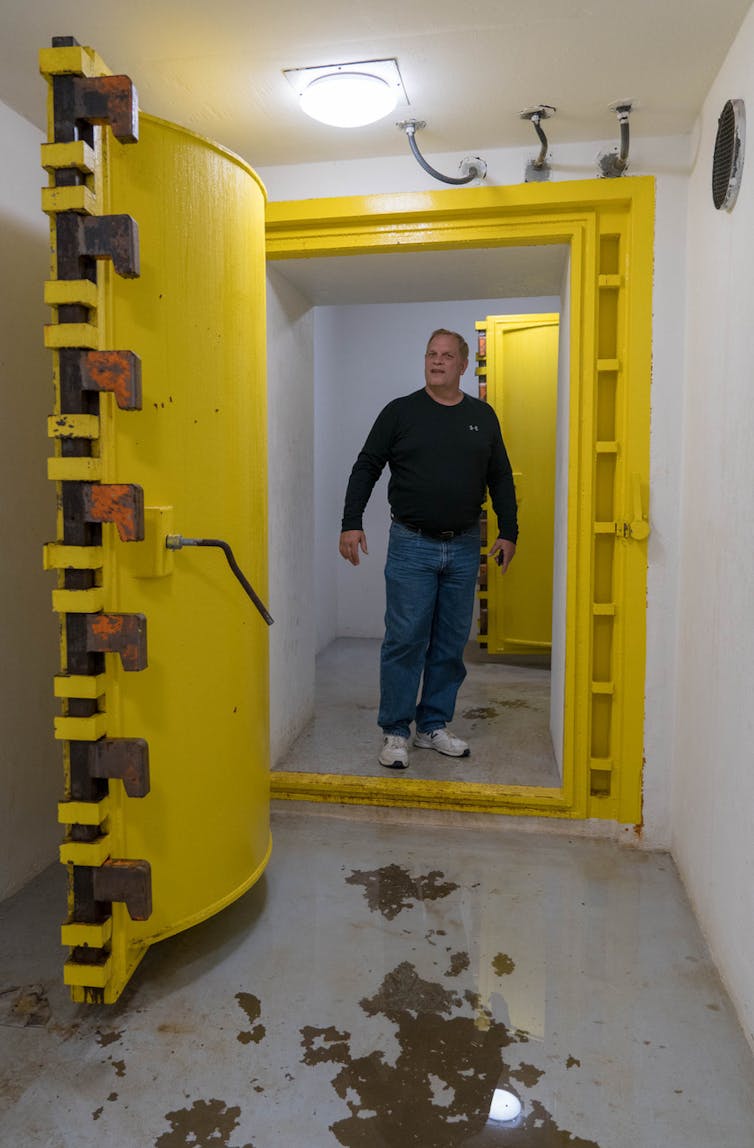
Hall’s team had drilled 45, 300-ft deep subterranean geothermal wells and built in a water filtration system that used UV sterilisation and carbon paper filters. The system can filter 10,000 gallons of water a day into three electronically-monitored 25,000 gallon tanks. Power to the bunker is supplied by five different redundant systems – so, if one goes down, there are four backups. This is crucial, since as a life support system, losing power would kill everyone in the facility. Hall said:
We’ve got a bank of 386 submarine batteries with a life of 15 or 16 years. We’re currently running at 50–60kW, 16–18 of which are coming from the wind turbine … However, we can’t do solar here … because the panels are fragile, and this is, after all, tornado alley. At some point we know that wind turbine is going to go too. I mean it won’t make it through five years of ice storms and hail, so we’ve also got two 100kW diesel generators, each of which could run the facility for 2.5 years.
Survival Condo has both private and communal areas, as you might find in any high-rise development. But in this tower block, during full lockdown mode there can be no external support. It must function as a closed system, where people are kept both healthy and busy until they are able to emerge.
Experiments in enclosed life-support systems conducted by the military (for submarines) and scientists (for spacecraft) have often neglected to consider social systems after lockdown. Hall says he recognises that sustainability is not simply about technical functionality. On my tour he opened another door to a 50,000 gallon indoor swimming pool verged by a rock waterfall, lounge chairs and a picnic table. It was much like a scene from a holiday resort – but without the sun.
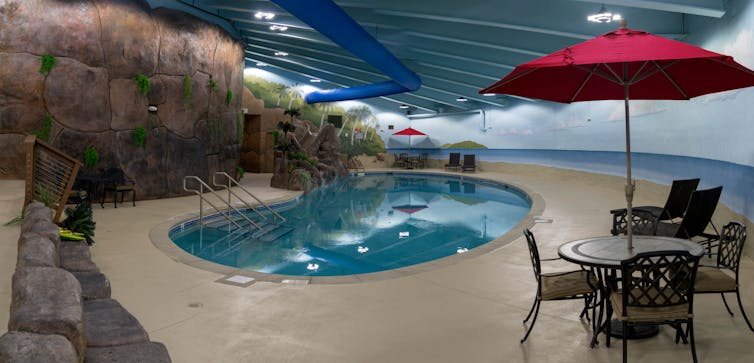
At the theatre and lounge level, we sat in leather recliners and watched a 4k screening of the Bond movie, Skyfall. The cinema was connected to the bar, which was intended to act as “neutral ground” for future residents. They had a beer keg system and one of the residents had provided 2,600 bottles of wine from her restaurant to stock the wine rack. As he showed me this, Hall insisted that recreation, sharing and community was as important to the condo’s design and management as the technical systems.
Given the severe limitations of underground living, anything extraneous must be eliminated. The entire building must be thought of as a single unit, where the actions of each resident inevitably effects all other residents. This is what makes the bunker more like a submarine than a tower block. In the event of a major incident, the umbilical cord to the world on the other side of the blast doors would be snipped and the clock would start ticking to a resupply.
On the other hand, in an era of surveillance dominated by what some deem to be a concerted push by Silicon Valley elites to eviscerate all forms of privacy, subterranea may be humanity’s last refuge against total transparency – at least for now. One prepper I interviewed suggested that the bunker he was building in eastern America was the best escape plan possible. He told me: “We can’t build a celestial ark like Elon Musk, we can’t leave the Earth, so we’re going to go into the earth. I’m building a spaceship in the Earth.”
The consultant
Inside the Survival Condo, Hall said, would also be a system of rotating jobs for the five years, both so that people would be occupied (“People on vacation constantly get destructive tendencies”) and so that they would individually learn the different critical operations in the bunker. This was a lesson learned from the University of Arizona’s Biosphere 2 project. In fact, Hall hired a consultant who had worked on Biosphere 2 to assist in the planning of the Survival Condo who went over everything in meticulous detail. From the colours and textures on the walls to the LED lighting to help prevent depression. As Hall said:
People come in here and they want to know why people need all this “luxury” – the cinema, rock climbing wall, table tennis, video games, shooting range, sauna, library and everything … but what they don’t get is that this isn’t about luxury, this stuff is key to survival.
Hall believes that if these amenities are not built in, the brain keeps a subconscious score of “abnormal things” which is when depression or cabin fever creeps in. What he said next will no doubt have a strong resonance to all those in COVID-19 lockdown:
Whether you’re woodworking or just taking the dog for a walk, it’s crucial that people feel they are living a relatively normal life – even if the world is burning outside. People want good quality food and water, to feel safe and to feel they’re working together towards a common purpose. This thing’s got to function like a miniature cruise ship.
During the early days of the Cold War, governments, military and universities conducted numerous experiments to see how long people could withstand being trapped underground together. In a 1959 government study in Pleasant Hill, California, 99 prisoners were confined in underground lockdown for two weeks (an experiment which would never receive ethics approval these days). When they emerged, “everyone was in good health and spirits”, according to a spokesperson for the group. It seemed people could adapt and make do – just so long as they knew the situation was temporary. It was like a period of submergence in a submarine: cramped and uncomfortable, but tolerable as long as a plan to surface was in place, a destination in time plotted. That was precisely the model Hall was operating on – though, rather than two weeks, Hall was planning for up to five years in lockdown.
Both womb and tomb
Over 60 metres below the surface of the Earth, we looked over racks filled with 25-year shelf-life food stored on the grocery store level – a convincing replica of a supermarket, complete with shopping baskets, an espresso machine behind the counter and a middle-class American aesthetic.
Hall said they needed low black ceilings, beige walls, a tile floor and nicely presented cases because if people were locked in this building and they had to come down here to rifle through cardboard boxes to get their food, they would soon get depressed.
It was also necessary to implement a rule that no one could take more than three days’ worth of groceries because shopping is “a social event”. Hall said that “since everything in here is already paid for, you need to encourage people to come down here to smell bread and make a coffee and to chat or barter supplies and services”.
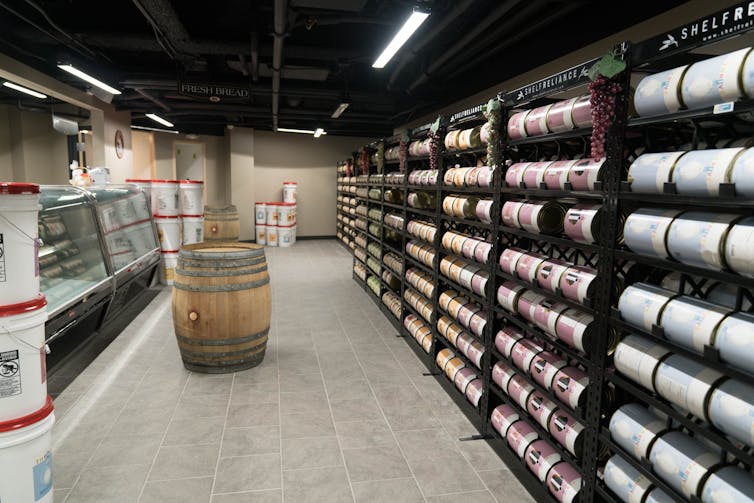
We visited one of the completed 1,800-square-foot condos, which felt like a clean, predictable hotel room. I looked out of one of the windows and was shocked to see that it was night outside. I guessed we must have been underground for more than a few hours at this point.
I had completely forgotten we were underground. Hall picked up a remote control and flicked on a video feed being piped into the “window” – an LED screen – much like you might see in a futuristic film. Oak leaves suddenly shuddered in the foreground just in front of our cars, parked outside the blast door. In the distance, the camouflaged sentry posted at the chain link fence was standing in the same place as when we arrived.
“The screens can be loaded up with material or have a live feed piped in, but most people prefer to know what time of day it is than to see a beach in San Francisco or whatever,” Hall explained. “The thing the consultant drilled in again and again was that my job as the developer was to make this place is as normal as possible. All that security infrastructure, you want people to know how it works and how to fix it, but we don’t want to be reminded all the time that you are basically living in a spaceship or a submarine.”
Emerging from the chrysalis
But all this preparation is for life during lockdown. Is there any prepping going on for life after the blast doors re-open? One prepper named Auggie, who was building a large-scale bunker in Thailand, told me: “I imagine walking through the doors of the bunker when it’s finally finished and feeling the anxiety drop out of my body. I imagine spending time in there with my family, safe and secure, becoming my best version of myself.” Another in South Dakota, when questioned about what they might do in their bunker, said:
Well, you could do anything, you could learn how to meditate, you could learn how to levitate, you could learn how to walk through walls. When you get rid of all the distractions and crap around us keeping us from doing these things, who knows what you can accomplish?
The bunker is imagined by some as a chrysalis for transformation into a “model self”, where preparations lead to a perfectly routine existence after which time a person can emerge as a superior version of themselves. Many of us experienced this playing out during the early weeks of the COVID-19 pandemic, which for some brought relief from unwanted travel obligations and for others provided a productive period of isolation and privacy. A utopia for some was a disaster for others, who were without the resources to hunker down and were left jobless, sick, and dead.
So in this sense, the rational, orderly, planned space of the bunker is the antithesis of what some see as the pointless acceleration and accumulation of modern life. These narratives contrast the media’s representation of prepping and bunker building as a gloomy, dystopian practice. My research found that prepping is ultimately hopeful, if a little selfish. Selfish because the preppers are looking out for themselves, given that they don’t trust the government to do so. However, as may of them have made clear to me during the current pandemic, the fact that they are self-sufficient has alleviated pressure on critical resources and health-care facilities, putting an altruistic spin on what looks to be a self-centered endeavour. Unlike survivalists, the goal of the prepper is not to exit society, but to help prop it up through personal preparedness.
One bunker builder in California explained to me that that “no one wants to go into the bunker as much as they want to come out of the bunker”. As such, the bunker is a form of transportation, but one that instead of transporting bodies and material through space, it transports them through time.
Hope from dread
To preppers, the bunker is both a controlled laboratory in which to build better selves, a place to reassert lost agency and a chrysalis from which to be reborn after a necessary “reset” of a messy, complicated and fragile world.
In the light of the COVID-19 pandemic it has become clear that the preppers are not social anomalies, but gatekeepers to understanding the contemporary human condition – just as survivalists of the past were a reflection of Cold War anxieties. Spaces like the Survival Condo seem improbable, if not impossible, but it’s the choice to build them that matters, because in action hope can spawn from dread. As Hall suggested at the end of our tour:
This was not a space of hope. The defensive capability of this structure only existed to the extent needed to protect a weapon, a missile – this bunker was a weapon system. So, we converted a weapon of mass destruction into the complete opposite.
But what the preppers are building is less important than our need to understand that prepping refracts underlying anxieties created by inequality, austerity, shrinking trust in government, despondency about globalisation and the speed of technological and social change. The COVID-19 pandemic is only likely to increase people’s dread – and therefore willingness – to normalise prepping practices. So it may well be that the future of humanity is not in the stars after all – but deep under the surface of the Earth.
Bradley Garrett’s new book Bunker: Building for the End Times, will be published by Allen Lane in August.

For you: more from our Insights series:
What will the world be like after coronavirus? Four possible futures
The end of the world: a history of how a silent cosmos led humans to fear the worst
To hear about new Insights articles, join the hundreds of thousands of people who value The Conversation’s evidence-based news. Subscribe to our newsletter.

